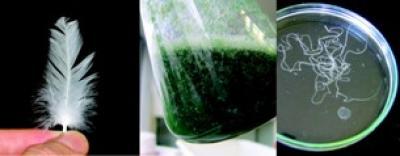It's hard to imagine a future where people are nostalgic for polyester but it may be just a thing of the past. 38 million tons of synthetic fibers are made each year and some new advancements in regenerated protein make it possible to use environmentally sustainable clothing fiber instead.
So one day you may snuggle up in warm, cozy sweats made of chicken feathers or pants made of wheat - your blue jeans could be "green."
Researchers in Australia are reporting that their new advances are paving the way for such exotic new materials made from agricultural waste or byproducts to hit store shelves as environmentally-friendly alternatives to the synthetic fabrics we now use. They review research on the development of these next generation eco-friendly fibers, which will produce fabrics with a conventional feel, in Biomacromolecules.

Eco-friendly fabrics from renewable materials, such as chicken feathers. Photo: American Chemical Society
In the article, Andrew Poole, Jeffrey Church and Mickey Huson note that scientists first produced commercial fabrics made of nontraditional materials — including milk proteins, peanuts, and corn — almost 50 years ago. Although these so-called "regenerated" fabrics had the look and feel of conventional protein-based fabrics such as wool and silk, they tended to perform poorly when wet. This problem, combined with the advent of petroleum-based synthetic fibers, caused the production of these unusual fabrics to stop, the researchers say.
Amid concerns about the environment and consumer demand for eco-friendly products, renewable fabrics made from nontraditional agricultural materials are now poised to make a comeback, the scientists say. Promising fabric sources include agricultural proteins, such as keratin from scrap chicken feathers and gluten from wheat, they say. The scientists describe advances in nanotechnology and chemical cross-linking that can improve the strength and biodegradability of these fabrics, paving the way for commercial production of eco-friendly clothing, furniture upholstery and other products.


